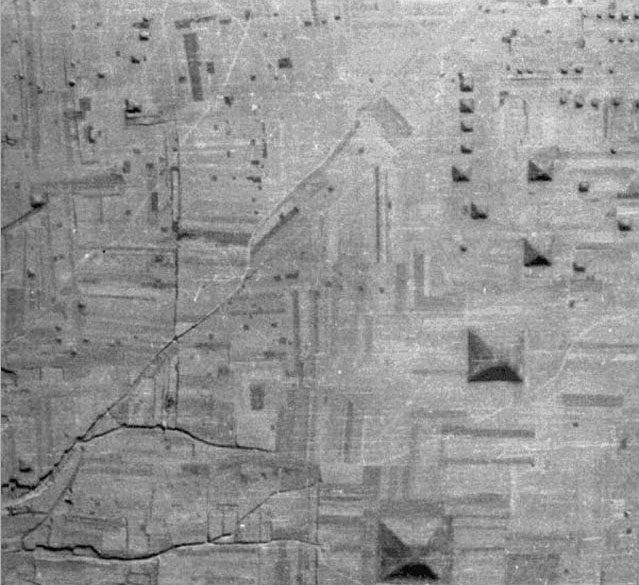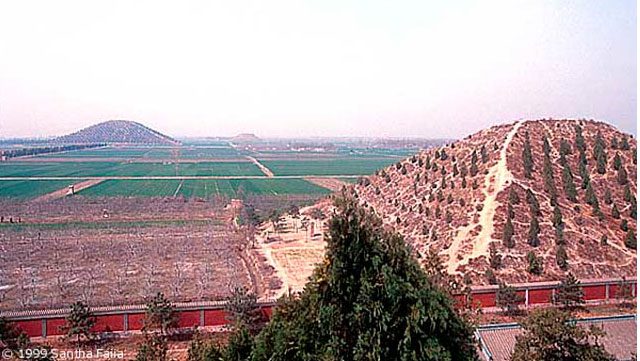To this day, the mysterious pyramids in China remain a challenge to our understanding of ancient history and culture. Let’s explore the secrets behind these enigmatic architectural structures.
Discovery of the Mysterious Pyramids
According to The Archaeologist, over 100 km outside the ancient city of Xi’an, in Shaanxi Province, China, amidst dense forests, there are dozens of pyramid-shaped hills shrouded in thousands of years of mystery. These pyramids were first discovered by Fred Meyer Schroder, an American merchant, in 1912. He documented a detailed description in his journal, stating that he saw a massive pyramid approximately 1,000 feet (over 300 meters) tall, surrounded by several smaller pyramids.

Photo of the pyramid taken by Colonel Maurice Sheahan. (Image: DRB).
According to Schroeder, upon inspecting the pyramids, he noticed that they had no entrances. The pyramids were constructed from many identical stone blocks, each square with sides measuring about 90 cm.
The second person to confirm the sighting of these pyramids was James Gaussman, an American pilot. In 1945, Gaussman was tasked with flying a C-47 transport plane to deliver supplies from a U.S. military base in India.
One day, while flying back to the base, his plane suddenly had engine trouble, forcing Gaussman to lower his altitude. As he flew along the mountainside, he unexpectedly spotted a flat valley stretching out before him. Then the pyramids, seemingly larger than the Egyptian ones, came into view one after another. Gaussman was overwhelmed by the sight and circled back for a better look at the pyramids.

Images of the mysterious pyramids in China captured from above. (Image: DRB)
Two years later, Colonel Maurice Sheahan, the Far East Director of Trans World Airlines, also had the opportunity to fly over the pyramid area, following Gaussman’s guidance. This time, being well-prepared, Sheahan managed to take several photos that were later published in The New York Times on March 28, 1947.
However, the Chinese archaeological community denied the existence of the pyramids in Xi’an, despite the evidence provided by Sheahan’s published photos. Some acknowledged the existence of these structures but claimed they were not “pyramids” but merely “trapezoidal tombs.”
Expert and Scientist Explanations
It wasn’t until 50 years later that a German explorer named Hartwig Hausdorf and his colleagues were determined to uncover the truth. They traveled to the ancient city of Hanyang, about 40 miles from Xi’an, where the research team observed at least 16 pyramids in the area. Experts believe this discovery could overshadow Howard Carter‘s discovery of Tutankhamun in 1922. The research team was astonished to find many bushes planted on the sides of the pyramids. They believed the local government was attempting to conceal these pyramids by blending them into the surrounding natural environment.

Many bushes were planted on the sides of the pyramids. (Image: DRB).
The construction method of these pyramids bears many similarities to the pyramids of Teotihuacan (Mexico), with tiered structures and earthen stepped sides. The tops of the pyramids were made flat, resembling the rectangular structures commonly seen among the Maya.
Experts suggest that these pyramids are not only unique architectural works but also hold many secrets about the ancient history and culture of China. These architectural structures are believed to be between 4,500 and 8,000 years old. They believe these pyramids may be arranged to reflect the shape of a particular constellation in the sky.

Many Western scientists have proposed hypotheses regarding the purpose of these pyramids. (Image: DRB).
According to Discovery and The Travel, there are numerous theories regarding the purpose of these pyramids. Some believe they may have been used as a secret military base designed for nuclear warfare. Others speculate that they could be the tombs of emperors.
The mysterious pyramids in China are not only unique architectural structures but also significant evidence of the development of ancient civilizations. Although many mysteries remain unsolved, they continue to open up new avenues for research, enhancing our understanding of humanity’s rich past.


















































